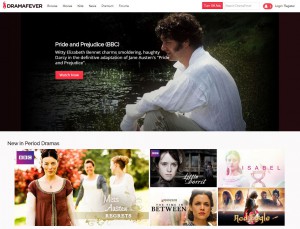
After more than 40 years of operation, DTVE is closing its doors and our website will no longer be updated daily. Thank you for all of your support.
Minority report: the search for niche OTT audiences
 Serving niche audiences on a global scale is becoming an increasingly viable business model in an online world, reports Andy McDonald.
Serving niche audiences on a global scale is becoming an increasingly viable business model in an online world, reports Andy McDonald.
As over-the-top video starts to mature, the market is increasingly giving rise to players that cater for specific audiences. While the rise of the Netflixes, Amazons and Hulus of the web offers a new route to market for TV and movie content, there is a new wave of online players specialising in specific genres – ranging from foreign content to documentaries and factual programming, little-known drama and Japanese animation.
Online distribution is cost-effective when targeting small audiences, and the nature of the web means that small niches attain a significant scale when applied to a global market. A recent study by Horowitz Research claims that 88% of urban TV viewers now have the ability to stream video and states that multicultural viewers are more likely to have made OTT video a part of their lifestyle.
Lebara, a telecoms company that offers low-cost international calls, is just one of a number of companies looking to target this type of audience. In June, it moved into OTT video by launching a multi-ethnic content service aimed at migrants living in Europe.
Lebara Play kicked off with more than 150 TV channels and 3,000 movies from around the world, launching in the UK, Germany, Netherlands and France. The firm plans to roll out to the rest of Europe over the summer and worldwide by the year-end, starting with Australia and New Zealand, with the final stage of expansion to be North America.
Niche audience
Aditya Thakur, CEO of Lebara Play, says that the service is based on understanding migrants and supporting them – “from their first steps” in a new country, when they want to call home, to when they are more established and want to then be connected to the entertainment from their homeland.
In line with this, entertainment makes up just one part of a wider plan by Lebara to serve its audience with various apps and services. A Viber-style internet calling service and banking and travel products are all in the pipeline, according to Thakur.
Lebara Play – which is available on mobiles, tablets, computers, and selected set-top boxes – offers linear channels and VoD content aimed at Tamil, Turkish, French West African and English West African audiences in Europe. The catalogue is due to expand to include Romanian, Polish, Hindi and other packages covering 13 languages. Content partners to date include: Tamil broadcaster Sun Network; pan-African channel Ebony Life; Nigerian network Silverbird; French Nollywood movies channel Nollywood TV; Turkish channel ATV Avrupa; and African Movie Channel.
Thakur says that Lebara will not offer new language packs until it has licensed a comprehensive line-up for that given market – something he believes sets Lebara Play apart from some of its competitors. “There are a lot of packs out there [in the market]. We believe that what’s been constructed for migrants [previously] is very makeshift – a few channels here, a few channels there and you call it a booster pack, or an Asian pack, or whatever else, but it’s not really thought through. It doesn’t really give you the depth that people are looking for,” says Thakur. “As and when we introduce [new language] packs we’re going to make sure that they’re fairly complete. Obviously we’re a legal player and we don’t have the luxury of just plucking out channels from thin air and offering them on our packs. It’s been done by a lot of satellite players across the region – we refuse to go that way. That’s the legal stand that we’ve taken.”
While Thakur cites piracy as a “big competitor” he claims that Lebara Play’s selling point is that it combines the best of live TV, and the best of VoD and catch-up “in one compelling offering at a very simple price”.
He also points to the very large addressable market for the service. “From the initial projections that we have done, we’ve put that number at something close to 15 million in Europe itself. This is the official stats, and we know that there’s lots more people out there that are not even declared on the official stats.”
Thakur says Lebara Play was made possible because of the increasing affordability of smartphones and availability of broadband. However, the service was also able to launch thanks to a technology partnership with SPB TV. A provider of OTT, IPTV and mobile TV solutions, SPB has worked on projects for the likes of Russian mobile operator MTS – delivering an online TV service across a large geographical area and various time zones for millions of customers. SPB co-founder Sebastian-Justus Schmidt says that technology is changing old distribution models, with “niches which couldn’t been addressed before now easy to access.” However, in Lebara’s case, he rejects the idea that the firm is even targeting a ‘niche’. “Lebara’s vision is to see the migrant community as a whole which is huge,” he says.
Reaching the diaspora
While Lebara is a major new player for in the migrant-focused OTT field, it is not the first mover. David Vargas-Racero founded Cloudio TV in 2011 as an internet TV and web video provider aimed at diaspora audiences, offering content packages based around various languages – including Arabic, French, Korean, Portuguese, Spanish, Tamil and Vietnamese. Vargas-Racero led the firm as CEO until earlier this this year. However, a shareholder dispute over what he describes as the future direction of the business saw the founder step down in May to set up a rival operation called Stream Republic.
Vargas-Racero says that Stream Republic, like Cloudio TV, aims to help international communities put their content online – delivering live channels and VoD across different platforms, all around the world – though he claims his new business will take a more tailored approach to individual markets.
“I’m looking to target specific communities on their own, rather than [be] a big store for everything,” says Vargas-Racero. “I’m creating Brasil Play, which is for Brazilians, Carib Play, which is for the Caribbean diaspora living in Europe, and we are now in discussions with other communities. Everything we’re doing is obviously all 100% licensed with the content providers, so we do it either by partnerships or directly doing content acquisition.”
Beyond these initial two launches, Vargas-Racero, who was previously head of broadcast and IT at Current TV in the UK, says that Stream Republic is considering Chinese and Japanese content offerings, and is also looking at the Indian and Arabic markets.
He says that the plan for Stream Republic is to launch brands for specific markets, with apps for smart TVs, smartphones and tablets running iOS and Android, and platform operator-provided set-top boxes. This approach is designed to give each Stream Republic-launched brand a unique identity and allow each service to operate in the language native to that market. “It’s easier for marketing as well – the message is clear,” says Vargas-Racero. “Cloudio is more like one app for everything, which is more difficult to market. I’m stepping away from that.”
Describing Stream Republic’s over-the-top strategy, Vargas-Racero explains that this route to market is an increasingly sensible choice for smaller broadcasters looking to reach targeted audiences. “The OTT market is extremely good for reaching these communities, because right now the satellite delivery is becoming too expensive. There has also been a huge increase in piracy and the actual satellite providers are no longer able to compete in an affordable way,” he says. “We’re talking about content providers that normally have less than 40,000 subscribers, so the cost of satellite is not affordable. Satellite becomes a very good way for delivering communications once you are in a high volume of millions. But for this small volume, it becomes too expensive for companies to grow.”
Operating in the same space is CaribBe TV, which launched last year in partnership with Cloudio. The latter provides the technical platform for the service, while CaribBe TV takes care of the content and marketing.
The service was designed fill a gap in the market for Carribean programming in the UK market. However, Jo Spalding, CaribBe’s founder and the managing director of parent firm Caribbean Media Partners, says the company has broader aims. “According to the stats we have, the Caribbean diaspora in the UK is about one million. That’s just the UK, but we are planning to expand into other European countries as well,” says Spalding. “Ireland will be first, followed by the Netherlands, Scandinavia, Germany. We are first of all concentrating on the Northern European countries, but we will be looking at the rest of Europe as well.”
Currently CaribBe TV offers 10 channels – some are pan-Caribbean like Caribvision, Tempo an d One Caribbean TV, while others are from particular islands, such as Hype TV from Jamaica and Gayelle from Trinidad and Tobago. Spalding says the service also aims to reinforce its on-demand offering over the next six months. The firm’s international expansion plans will sees CaribBe launch formally in five European markets by the end of the year. This will mean providing different language versions of the service, and ideally having a company representative in each country to do the marketing.
d One Caribbean TV, while others are from particular islands, such as Hype TV from Jamaica and Gayelle from Trinidad and Tobago. Spalding says the service also aims to reinforce its on-demand offering over the next six months. The firm’s international expansion plans will sees CaribBe launch formally in five European markets by the end of the year. This will mean providing different language versions of the service, and ideally having a company representative in each country to do the marketing.
“Technically we’re already available all over Europe, but we haven’t announced the service; we haven’t made a formal launch in the other markets. Someone who finds the Cloudio app can download [it] and they can order a CaribBe.TV package from anywhere in Europe. As a matter a fact, we have subscribers from eastern Europe, Russia, Yugoslavia and Scandinavia already. It means that people have an interest,” says Spalding.
He claims that CaribBe’s offers “the most comprehensive Caribbean package in the market so far”. However, he believes that the service has the potential to reach an even wider audience. “Caribbean content, in particular when it comes to travel, lifestyle, music and entertainment, obviously has an appeal which goes well beyond people of Caribbean descent – so this is what we want to capitalise on and reach a bigger audience,” says Spalding.
Exporting foreign content
DramaFever is an OTT service that has, in a similar way, already outgrown its original intended niche. The US-based service was launched in 2009 by two college friends – Suk Park and Seung Bak –who came up with the idea of bringing Korean drama to the US market after noticing on a business trip to China that this content was already gaining popularity outside of its home market.
DramaFever’s head of marketing, Yale Wang, says: “When they returned to the US they wanted to see what was available here. They went online, they found a bunch of sites that were offering lots of Korean content but it was all pirated – it wasn’t licensed. So they spent the first nine months of the business just basically going out to South Korea, knocking on doors and getting folks to license them their shows legally.”
After starting the site with an initial offering of roughly a dozen shows, DramaFever’s founders began to grow the service and soon made an unexpected discovery. “Originally the site was targeted towards Korean Americans or people that had emigrated from South Korea,” says Wang. “It very quickly became apparent that was not our audience base. Instead we had actually cultivated a base of young millennials, especially young women. If I was to give you a demographic breakdown, it’d be probably 45% Caucasian, 25% Latino, 20% African-American and 10% Asian-American.”
With its audience demographic in mind, DramaFever has since expanded its drama remit to include telenovelas, shows from elsewhere in Asia and even English-language content. The firm recently signed a deal with BBC Worldwide North America to bring a number of period dramas to the service, including Pride and Prejudice and Tess of the d’Urbervilles. “We are region-agnostic,” says Wang. “Nowadays we care less about Asian content. We still try to get the best out of Asia, because that’s where our roots began. But what we want to get is the best from across the world. So we want content that first and foremost speaks to our existing core audience of young millennial females.”
The success that DramaFever has achieved with its Asian catalogue – which currently still accounts for the majority of viewing on the site – has not been lost on industry-watchers. Last October it was acquired by Japanese telco SoftBank and the firm has also diversified its output by developing further on-demand sites in partnership with early investor AMC.
DramaFever currently powers AMC’s Sundance-branded Doc Club site – an SVoD service focused around feature-length documentaries. It is also now in the beta testing phase for a new joint project with AMC – a subscription horror movie site called Shudder. Wang says DramaFever has plans to replicate this model and explore further niches in the future – provided there’s a business case for doing so and the right partner is involved. “I think AMC’s been a fantastic partner so far, so we don’t want to do this on our own. It’s the type of thing that we bring a lot of expertise to the table in terms of marketing, as well as product and technology. But we like working with other companies as well,” he says.
Switzerland-based Viewster is another OTT business that has evolved over time. Originally starting out as business-to-business video aggregator for companies like Netflix and Hulu, the firm launched a consumer VoD platform in 2010, and has now started putting a strong focus on anime content.
“The moment we opened up our own homepage we noticed that there is a huge potential for free, advertising-based video-on-demand,” says Viewster’s head of marketing, Tilman Eberle, describing a cosmopolitan, international audience eager to watch content that has not necessarily been produced in their home country or in their first language.
Eberle says that Viewster’s decision to focus on Japanese-originated anime content – targeted at viewers outside of Japan – has opened it up to a very loyal and very strong target group. He claims that since the site shifted focus onto this, key performance indicators like time on site, videos watched and return rate have “jumped up by at least three times.”
Anime provides a “large niche” for Viewster to tap into, according to Eberle. As a “wild guess” he estimates that there could easily be around “20-30 million real core, hardcore fans in the western countries like North America and Europe for that kind of content.”
On top of this, Viewster retains a catalogue of movies and TV shows spanning different genres such as sci-fi, fantasy, action, adventure and comedy. Eberle says “we see a much larger potential in reaching a huge consumer audience beyond only anime fans. But there are a lot of people who are really fond of genre content and will get access to anime through adjacent content that they will find on our platform.”
Viewster recently appointed former Bandai Namco Games executive Rob Pereyda as chief strategy officer and CEO of its US subsidiary, and the firm now has plans to launch a premium video offering in this market – diversifying its existing ad-supported model.
Eberle believes that while there is not much space for small OTT players to compete against heavyweight contenders like Netflix on a broad library offering, “we can give the audience a different experience that we are specialised in.”
Mining the niche
Anime is just one of a wide range of niche topic areas that are now available in the OTT video space. In March this year, a new SVoD service from Discovery Channel founder John Hendricks, called CuriosityStream, went live in the US. The independent venture offers premium factual programmes on an ad-free, subscription basis, taking Hendricks’ “vision of accessible and curated factual programmes to the social media generation.”
Hendricks’ daughter and CuriosityStream president Elizabeth Hendricks North says that her father had envisioned for more than a decade “a service that could be ad-free and allow people to see really great factual shows and documentaries without interruption of commercials. So it’s been a long time in the making in those terms.”
Since he retired from Discovery last year, North says that CuriosityStream has been Hendricks’ “passion project” and that the service has now come to fruition with the right team members in place to drive it forwards. Steve Burns, who has spent more than 25 years in executive roles at National Geographic and Discovery Networks, is a notable addition to the firm as executive vice-president of production and acquisition.
North says that CuriosityStream has so far seen its subscriber numbers grow by 20% week-over-week and that it has doubled its content offering since launch. “We have about 300 hours [of content] on the site and we’re expanding right now. What we’re also going to try and do over this next year is refine our platform and make sure that we have content available in as many territories as possible internationally,” says North.
CuriosityStream aims to expand into Canada “as soon as possible” and from there move into other English-speaking markets and territories, says North. It is also looking to expand in other areas, looking in particular to add 4K, ultra high-definition content to the service. “We’re really excited about breaking into 4K and offering that to subscribers. It’s a small market right now, but we see it in the way that HD was back over a decade ago,” says North. “The difficult part is making sure that we can deliver it in a quality fashion. We’re working hard on creating smart TV apps that will help us stream 4K live to viewers, so that’s part of our mission this year – to get the technology down for delivery.”
Currently CuriosityStream offers two subscription tiers – US$2.99 (e2.70) per-month for standard definition resolution content, or US$5.99 per-month for HD, with plans to add a third, 4K resolution option later this year priced at around US$10 per-month.
The firm has also commissioned a 20-part series in 4K called Big Picture Earth. This feature scenes from some of the world’s most spectacular locations and will be produced by David Conover, the filmmaker behind Discovery series Sunrise Earth.
Another notable original series that is due debut on CuriosityStream as part of its short-form library is Destination Pluto, which will feature footage from the New Horizon mission to the distant planet. The firm’s stated strategy is to mix a select number of commissioned shows with acquisitions and it has already signed content deals with non-fiction producers including the BBC, NHK, ZED, Terra Nova, and Flame Distribution.
“We’ve created a different way for finding documentaries on CuriosityStream by topic, rather than by title or actor. So I don’t think we’re competing with anyone now. Some people are going to join this OTT revolution and, yeah, we’ll have competitors soon, but I think right now we’re still finding our platform and we’re really focusing on creating the best product possible,” says North.
While the likes of Netflix and Amazon have captured the broad general interest OTT market, there appears to be a plenitude of rich avenues for online video players to specialise in and explore a range of subject areas – offering a depth of content unavailable elsewhere online.
As Yale Wang at DramaFever says: “At the end of the day, the consumer doesn’t want to pay US$200 every month and watch maybe five channels and get 200 that they don’t care about. The internet’s great for letting consumers just search out what they want and pay for exactly what they want.”


